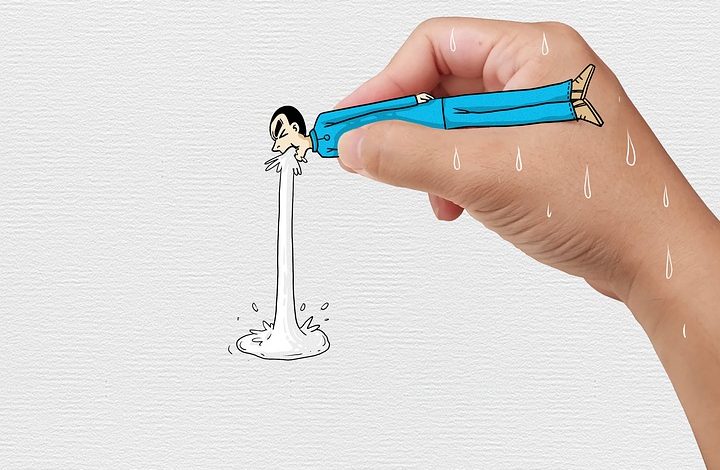25 Common Drugs That Can Cause Vomiting

Throwing up, also known as vomiting, is a natural reflex that occurs when the body needs to expel unwanted substances from the stomach or gastrointestinal tract. It can be caused by various factors, including infections, motion sickness, pregnancy, certain medications, and even emotional stress.
While vomiting is a common symptom that can happen to anyone, it is important to seek medical attention if it persists for an extended period of time or is accompanied by other symptoms such as severe abdominal pain, fever, or dehydration.
Vomiting can also be caused by medications (drug-induced nausea and vomiting) this is a common side effect of many prescription and over-the-counter drugs. Some medications that commonly cause vomiting include chemotherapy drugs, antibiotics, pain relievers, and psychiatric medications.
The frequency of drug-induced nausea and vomiting varies depending on the medication, the dose, and the individual patient’s sensitivity. Some medications are more likely to cause nausea and vomiting than others, and some patients may be more susceptible to these side effects. According to some studies, up to 40% of patients receiving chemotherapy may experience nausea and vomiting as a side effect of the treatment.
Common Medications That Can Cause Vomiting
Here is a list of 25 medications that can cause vomiting:
here are some examples of how specific medications can cause vomiting:
1. Cisplatin: This chemotherapy drug can cause nausea and vomiting due to its effects on the digestive tract, as well as its ability to trigger the release of chemicals in the brain that cause nausea and vomiting.
2. Ibuprofen: This NSAID can cause nausea and vomiting by irritating the lining of the stomach and reducing the production of protective prostaglandins.
3. Fluoxetine: This antidepressant can cause nausea and vomiting by increasing the levels of serotonin in the digestive tract, which can stimulate the vomiting reflex.
4. Codeine: This opioid pain reliever can cause nausea and vomiting by slowing down the movement of food through the digestive tract and irritating the lining of the stomach.
5. Haloperidol: This antipsychotic can cause nausea and vomiting by blocking dopamine receptors in the digestive tract, which can slow down the movement of food and trigger the vomiting reflex.
6. Diphenhydramine: This antihistamine can cause nausea and vomiting by blocking histamine in the digestive tract, which can disrupt the normal functioning of the digestive system.
7. Ferrous sulfate: This iron supplement can cause nausea and vomiting by irritating the lining of the stomach and intestines, as well as by stimulating the vomiting reflex.
8. Metformin: This medication used to treat type 2 diabetes can cause nausea and vomiting as a common side effect, especially when starting treatment or increasing the dose. It’s thought to be due to metformin’s effects on the digestive tract, including slowing down the movement of food.
9. Lithium: This medication used to treat bipolar disorder can cause nausea and vomiting as a common side effect, particularly when starting treatment or increasing the dose. It’s thought to be due to lithium’s effects on the digestive tract, as well as its ability to stimulate the vomiting center in the brain.
10. Methotrexate: This chemotherapy drug can cause nausea and vomiting due to its effects on the digestive tract, as well as its ability to trigger the release of chemicals in the brain that cause nausea and vomiting.
11. Propranolol: This medication used to treat high blood pressure and other conditions can cause nausea and vomiting as a common side effect. It’s thought to be due to propranolol’s effects on the digestive tract, as well as its ability to slow down the heart rate.
12. Acetaminophen: This pain reliever can cause nausea and vomiting in some people, particularly when taken in high doses. It’s thought to be due to acetaminophen’s effects on the digestive tract, as well as its ability to stimulate the vomiting center in the brain.
13. Erythromycin: This antibiotic can cause nausea and vomiting as a common side effect, especially when taken on an empty stomach. It’s thought to be due to erythromycin’s effects on the digestive tract, including slowing down the movement of food and irritating the stomach lining.
14. Amoxicillin: This antibiotic can cause nausea and vomiting in some people, although it’s not a common side effect. It’s thought to be due to amoxicillin’s effects on the digestive tract, as well as its ability to stimulate the vomiting center in the brain.
15. Tamoxifen: This medication used to treat breast cancer can cause nausea and vomiting as a common side effect, although the exact mechanism is not well understood.
16. Clozapine: This antipsychotic can cause nausea and vomiting as a common side effect, as well as other digestive issues. It’s thought to be due to clozapine’s effects on the digestive tract and the vomiting center in the brain.
17. Indomethacin: This NSAID can cause nausea and vomiting as a common side effect, particularly when taken on an empty stomach. It’s thought to be due to indomethacin’s effects on the digestive tract, including reducing the production of protective prostaglandins and irritating the stomach lining.
18. Vincristine: This chemotherapy drug can cause nausea and vomiting due to its effects on the digestive tract, as well as its ability to trigger the release of chemicals in the brain that cause nausea and vomiting.
19. Carbamazepine: This medication used to treat seizures and other conditions can cause nausea and vomiting as a common side effect. It’s thought to be due to carbamazepine’s effects on the digestive tract, as well as its ability to stimulate the vomiting center in the brain.
20. Dexamethasone: This corticosteroid can cause nausea and vomiting as a common side effect, although it’s often used to prevent nausea and vomiting caused by chemotherapy. The exact mechanism is not well understood.
21. Digoxin: This medication used to treat heart failure and other conditions can cause nausea and vomiting as a common side effect, particularly when taken in high doses. It’s thought to be due to digoxin’s effects on the digestive tract and the vomiting center in the brain.
22. Methylprednisolone: This corticosteroid can cause nausea and vomiting as a common side effect, although it’s often used to prevent nausea and vomiting caused by chemotherapy. The exact mechanism is not well understood.
23. Naproxen: This NSAID can cause nausea and vomiting in some people, although it’s not a common side effect. It’s thought to be due to naproxen’s effects on the digestive tract, as well as its ability to stimulate the vomiting center in the brain.
24. Ondansetron: This medication is used to prevent nausea and vomiting caused by chemotherapy and other treatments. It works by blocking serotonin receptors in the brain and digestive tract.
25. Tramadol: This opioid pain reliever can cause nausea and vomiting as a common side effect, particularly when taken in high doses. It’s thought to be due to tramadol’s effects on the digestive tract and the vomiting center in the brain.
How To Cope With Drug-Induced Nausea And Vomiting
If you’re experiencing drug-induced nausea and vomiting, there are several things you can do to cope:
1. Talk to your doctor: Let your doctor know about your symptoms. They may be able to adjust your medication dose or switch you to a different medication that’s less likely to cause nausea and vomiting.
2. Take your medication with food: Taking your medication with food can help to reduce the likelihood of nausea and vomiting. You should check with your doctor or pharmacist to see if this is appropriate for the medication you are taking, as some medications need to be taken on an empty stomach.
3. Stay hydrated: Vomiting can lead to dehydration, so it’s important to drink plenty of fluids to stay hydrated. Sipping water, clear broth, or electrolyte drinks can help to keep you hydrated.
4. Rest and relax: Resting and relaxing can help to reduce nausea and vomiting. Try lying down or sitting in a comfortable position, and avoid activities that can make you feel worse, such as reading or watching TV.
5. Use anti-nausea medication: Over-the-counter medications such as bismuth subsalicylate (Pepto-Bismol) or meclizine (Dramamine) can help to reduce nausea and vomiting. Your doctor may also prescribe anti-nausea medication, such as ondansetron (Zofran) or prochlorperazine (Compazine).
6. Try alternative therapies: Some people find that alternative therapies, such as ginger or acupressure, can help to reduce nausea and vomiting. You should check with your doctor before trying any alternative therapies to make sure they are safe for you to use with your medication.
It’s important to talk to your doctor if you’re experiencing drug-induced nausea and vomiting, as it can be a sign of a more serious problem. Your doctor can work with you to find the best treatment options to help manage your symptoms and improve your overall health and well-being.





